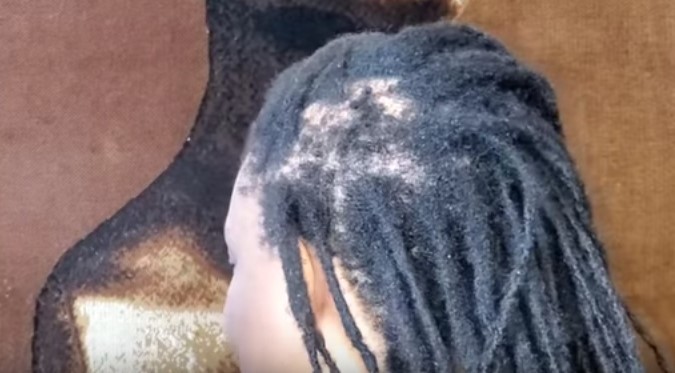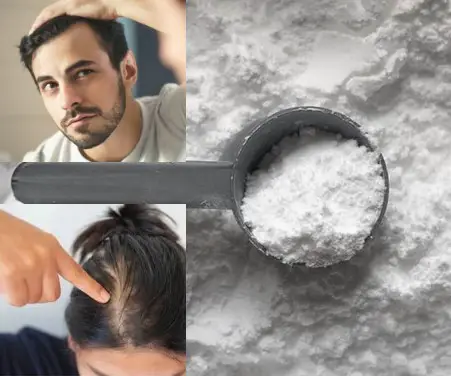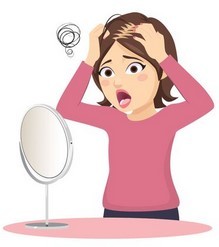Do wigs cause hair loss? This question gets asked in the wig community, but it could have very different answers depending on whom you ask. Some wig experts might say that wigs don’t cause hair loss, as long as you take good care of your wig and don’t wear it too much, while others might argue that wearing wigs for more than six weeks could even lead to permanent hair loss in some cases.
We get it. You love your wig. You may even have more than one unit in your collection. But how much is too much when it comes to wearing a wig? Can wearing wig damage your hair? If you wear a wig every day, will your hair fall out? We asked the experts to get some answers.
There are many reasons why women, and men, choose to wear wigs, hairpieces, or hair extensions. Whether you’re trying to hide or cover up crown balding, bald spot, thinning hair, receding hairline, or you’re amid your balding stages, denial of growing your hair back with balding crown treatment. Wearing a wig can be a simple and effective solution to many people’s hair loss problems. The obvious question, though, is if I wear a wig will my hair fall out? We asked the expert Dr. Elyse Love to find out what she had to say about the causes of hair loss related to wearing wigs. So Continue reading.
There are plenty of advantages to wearing a wig. Not only can they offer the fastest and most convenient solution on those days you’re unable to manage your real hair, but they can also help protect your hair from harm.
What is Traction Alopecia?
Traction Alopecia is a form of hair loss resulting from constant tension or pulling on hair follicles. It may develop as a result of wearers of certain kinds of wigs and other protective styles, making certain ladies more susceptible to this condition.
“Traction alopecia is a lifestyle disorder,” states New York City dermatologist Dr. Elyse Love. “Black women are not biologically more likely to experience traction alopecia. However, haircare practices in the Black community are more likely to include traction-causing maneuvers. Detangling, heavy braids, long weaves, and styling of leave-out hair are common causes of traction alopecia.”
As many of us continue to work from home, there’s a better moment to get your hair’s natural locks in good condition by learning more about traction alopecia and learn not just how to treat it but also how to stop it from recurring.
We spoke to Dr. Love, along with fellow dermatologists who are board-certified, Dr. Crystal Aguh, who was part of the traction-alopecia-focused documentary, Pretty Shouldn’t Hurt, created by un-ruly.com in collaboration and Dark & Lovely, in addition to Jesseca Dupart, CEO and the founder of Kaleidoscope Hair Products, to give you all the information you need to know about.
Also See: Alopecia Areata Wigs
How Can I Tell If My Hair Is Falling Out From Wearing A Wig?
If you’re worried about whether or not wearing a wig is causing your hair to fall out, there are a few things you can look for. First, take a close look at your wig.
- If your hair looks thinner than it did when you first bought it, that could be a sign that your hair is thinning.
- Additionally, if you notice any bald spots on your scalp, that could signify that your wig is damaging your hair.
If you’re experiencing any of these symptoms, it’s best to consult with a doctor or dermatologist to get their professional opinion.
What Types of Wigs Can Cause Traction Alopecia?
“Wigs that are super tight can cause traction alopecia,” says Dupart. “Also any wigs that require gluing or bonding, which is not healthy for the hair, especially if there is an unskilled person applying. Synthetic bands in wigs can also cause problems, especially for those with sensitive skin.”
While clips-in and lace front hair wigs provide:
- Complete coverage of your hair.
- Wearing a wig often can result in hair damage.
- Thinning.
- Baldness on certain parts of your scalp.
What Are Areas of the Scalp More Prone to Thinning?
According to Dr. Aguh and Dr. Love, traction-related alopecia usually results in hairline thinning because of the delicate hair that grows on the scalp. “This hair is also more likely to undergo pulling and tugging in an attempt to ‘lay’ or ‘tame’ the edges,” according to Dr. Love, which is the most common practice with a U-wig or half-wig.
It can also be seen in other areas. “Hair on the vertex scalp (crown) is also particularly susceptible to traction alopecia,” she says.
How Long Does It Take for Traction Alopecia to Develop?
In her time as a stylist and haircare expert, Dupart has seen her fair number of hair loss stories and claims that the timing will differ for everyone.
“It depends on your go-to style or chemical process, and whether you wear a ponytail, weave, wig, or have a poor diet,” she says. “With hair friction, it usually takes time for the breakage or follicle damage. Those tight hairstyles that give an instant facelift also can slowly recede the hairline.”
It’s why it’s crucial to be aware of using wigs with too much tension and opting for looser styles.
When Is It Time to See a Dermatologist or a Trichology’s?
Stop wearing your wigs when you notice hair loss and set an appointment with an ophthalmologist or dermatologist. There’s a good chance that your appearance causes your alopecia-related condition, but other conditions could contribute to the issue.
“I want to stress that you should avoid trying to self-diagnose, especially if your hair loss is worsening,” says Dr. Aguh. “Traction alopecia could appear like other types of loss of hair, such as Alopecia Areata and hormonal thinning and a particular type of loss known as frontal fibrosing alopecia. If you’ve not noticed an improvement in your hair loss after cutting back on extensions and taking care of your hair, it is recommended to have an official evaluation conducted by an experienced dermatologist certified by the board.”
The MD will explain that different hair loss types require various treatments. To determine the solution, you need first to be diagnosed properly, and the sooner you consult an expert and get a diagnosis, the more effective. “The great thing about traction is it is reversible in the early stages,” says the doctor. Love.
How Do You Treat Traction Alopecia?
“Anti-inflammatory injections can be helpful for traction alopecia that is slow to recover,” says Dr. Love. “In addition, topical minoxidil can help speed up the recovery process. Platelet-rich plasma also has shown early promising data for stimulating regrowth in traction alopecia.”
In the case of severe cases For severe cases, for severe cases, Dr. Aguh says the only solution is hair transplants, which can be costly. “All the more reason to make sure traction alopecia is diagnosed early,” she says.
To ensure your hair stays healthy and strong, Dupart suggests applying her brand’s nourishing Miracle Drops around the hairline between two and three times per week, along with her Therapy Shampoo on washing days.
“[This] haircare line is created for scalp and hair restoration and overall therapy for your hair,” she describes. “It has a cool-minty sensation that purifies the scalp and hair follicles to help grow healthy hair.”
All three experts acknowledge that frequent gentle massages of the scalp can improve circulation to your scalp. It’s important to remember that no matter which method of treatment you choose, the hair growth process isn’t quick and may take a few months to see the results.
How Can I Style My Hair to Hide Any Thinning?
Wearing a wig is a fantastic opportunity to be creative in terms of the styling aspect of the hair. “The key is to not put tension or adhesives on or around the affected area,” Dupart says. Based on where the thinning occurs, the best option is to move your hair in an opposite direction to cover it or select hair that does not add any tension to the hair.
If you’re stuck, you should make an appointment to see a reliable hairstylist that can assist in avoid the hair from thinning and preventing it from getting worse, the doctor. Love says you must be aware of what you’re doing with your hair.
“Ultimately, the best treatment is a change in styling practices that minimizes pulling on the scalp,” she clarifies. “This will likely include being more mindful about who you pay to style your hair.”
Do wigs cause hair loss?
Turns out that wigs can cause hair thinning, but not baldness or complete hair loss. However, if you’re already experiencing hair loss, wearing a wig may speed up the process. Additionally, if you wear a wig that’s tight or uses harsh chemicals, it can damage your hair. So if you’re thinking about getting a wig, do your research first!
Tips for Dealing with Breakage During A Break from Wearing a Wig.
If you’re experiencing breakage from wearing a wig, you can do a few things to help minimize the damage.
- First, try thinner-looking wigs. They put less strain on your hair and are less likely to cause breakage.
- Second, take breaks from wearing a wig every few weeks to give your hair a chance to recover.
- And finally, take care of your wig and brush it regularly to avoid tangles and knots that can pull on your hair and cause breakage.
To learn more about how to deal with breakage when wearing a wig, check out our blog post: Tips for Dealing with Breakage During A Break from Wearing a Wig.
How Long Does It Take For The Hair to Start Growing Back After a Break From Wearing a Wig?
We asked the experts if you’re wondering how long it takes for the hair to start growing back after a break from wearing a wig. According to dermatologists, wigs can cause hair thinning and damage your hair if not used correctly. If you wear a wig regularly, it’s important to give your scalp and hair a break every few months to prevent further damage. It would help if you took a two-week break from wearing a wig every four to six months, says Dr. Whitney Bowe, board-certified dermatologist and author of The Beauty of Dirty Skin.
How Can I Prevent Traction Alopecia From Coming Back?
According to the doctor, do not wear wigs or any other form of a too-tight hairstyle. Aguh. Dr. Love also adds that it is important to review your entire routine for hair care.
“I think as we as Black women need to rethink the way we feel about our hair, and change the way we treat our hair,” she says. “Our hair does not deserve the punishment we give it.”
If you want to detangle your hair after washing day, your dermatologist advises using conditioners with plenty of slip, reducing the tension on your scalp. Ensure you remove hair from the ends to the roots to prevent pressure on the scalp and hair. If you decide to go with hairpieces or the hairstyle, be sure that you don’t leave your appointment feeling ill or any other type of discomfort on your scalp.
“These are all signs of inflammation,” Dr. Love shares. “The goal should change from making the style last the longest to making a beautiful style that supports the hair and scalp.”
It’s All Natural. From the tiniest coils to loose waves, We’re looking at natural hair and all its forms with expert tips on styling, maintenance, and hair care.
- AI Powered Bald Filter Online 2024: See Yourself with No Hair! - January 19, 2024
- Harklinikken Bad Reviews 2024: Analyzing Negative Feedbacks - January 18, 2024
- How to Get the Alex Eubank Hair | Step-By-Step Tutorial 2024 - January 18, 2024







